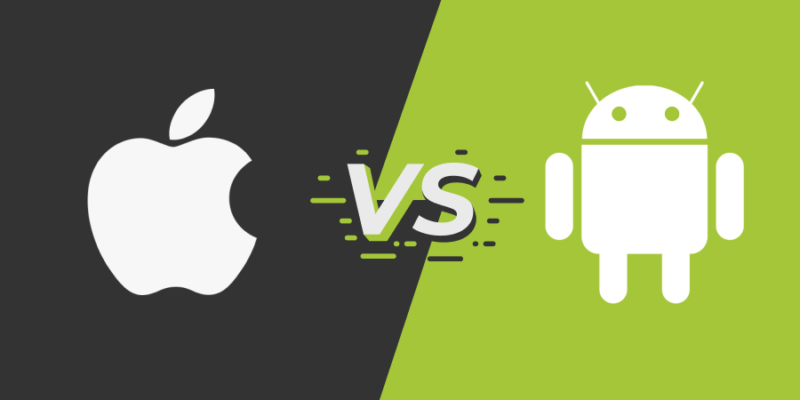
In the world of mobile operating systems, Android and iOS reign supreme. These two platforms power the majority of smartphones globally, each with its unique features, strengths, and user experiences. For businesses and developers, choosing between Android and iOS for app development is a crucial decision. This blog delves into the differences between Android vs iOS, highlighting key aspects such as user base, customization, app development, and market reach.
User Base and Market Share
Android
Android App Development Company by Google, is the most widely used mobile operating system globally. It holds a significant market share, particularly in regions such as Asia, Africa, and South America. As of 2023, Android powers approximately 72% of the global smartphone market. This widespread adoption is due to Android’s availability on a wide range of devices, from budget to high-end smartphones.
iOS
iPhone App Development Company by Apple, is known for its premium user experience and high-quality devices. While its global market share is smaller compared to Android, iOS dominates in regions like North America, Western Europe, and Japan. iOS users are often considered more affluent, with higher spending on apps and in-app purchases. As of 2023, iOS holds around 27% of the global market share.
Customization and User Experience
Android
Android is renowned for its customization capabilities. Users can personalize their devices extensively, from changing home screen layouts to installing custom ROMs. This flexibility extends to app developers, who can create unique user experiences tailored to specific needs and preferences. The open-source nature of Android allows for deep customization at both the software and hardware levels.
iOS
iOS, on the other hand, offers a more controlled and consistent user experience. Apple maintains strict guidelines for app design and functionality, ensuring a uniform experience across all iOS devices. While this results in a polished and intuitive user interface, it also means less room for customization. Developers must adhere to Apple’s design principles, which can limit the extent of personalization.
App Development
Development Environment and Tools
- Android: Android development primarily uses Android Studio, a powerful and comprehensive IDE that supports Java, Kotlin, and C++. The development environment is flexible, allowing developers to create apps for a wide variety of devices. Android’s open-source nature provides access to numerous libraries and frameworks, facilitating innovation and experimentation.
- iOS: iOS development uses Xcode, an integrated development environment exclusive to macOS. Swift and Objective-C are the primary programming languages for iOS development. Xcode offers a robust set of tools and a seamless development experience, but the requirement to use macOS can be a barrier for some developers.
App Store Policies and Approval Process
- Android: The Google Play Store has a relatively lenient app approval process compared to Apple’s App Store. This flexibility allows for quicker deployment and updates, enabling developers to respond rapidly to user feedback and market demands. However, it also means a higher potential for lower-quality apps.
- iOS: The Apple App Store has a stringent review process, ensuring that only high-quality apps are published. While this results in a more polished app ecosystem, the approval process can be lengthy and challenging for developers. Apple’s guidelines prioritize user experience and security, which can sometimes limit innovative features.
Market Reach and Demographics
Android
Android’s extensive market reach makes it an ideal platform for targeting a global audience. It is particularly popular in emerging markets due to the availability of affordable devices. Android users span a diverse demographic, providing opportunities for businesses to reach a broad and varied audience.
iOS
iOS users typically belong to higher-income brackets and exhibit higher spending power. The platform is favored in developed markets, making it an attractive choice for businesses targeting affluent customers. iOS users are also known for their loyalty to the platform, often showing higher engagement and retention rates.
Performance and Security
Android
Android offers robust performance, but the experience can vary significantly across devices due to hardware fragmentation. Google has made strides in improving security with features like Google Play Protect and regular security updates. However, the open nature of the platform can sometimes lead to vulnerabilities.
iOS
iOS is renowned for its seamless performance and integration with Apple’s hardware. The closed ecosystem allows Apple to optimize both software and hardware, resulting in a smooth user experience. iOS also boasts strong security features, including end-to-end encryption, biometric authentication, and frequent security updates.
Cost and Time to Market
Android
Developing for Android can be more cost-effective, especially for startups and small businesses. The availability of affordable development resources and a lower entry barrier make it accessible. However, the need to ensure compatibility across a wide range of devices can increase development time and complexity.
iOS
iOS development typically requires a higher initial investment due to the need for macOS hardware and the stringent app review process. However, the consistent user interface and device compatibility can result in a faster development cycle. iOS apps often generate higher revenue, potentially offsetting the initial costs.
Conclusion
Choosing between Android and iOS for app development depends on various factors, including target audience, budget, and desired features. Android’s vast market reach and customization options make it ideal for reaching a global audience and creating unique user experiences. iOS, with its premium user base, stringent quality control, and seamless performance, is perfect for businesses targeting affluent customers and ensuring a polished app experience.
Both platforms have their strengths and are suitable for different business needs. By understanding the key differences between Android and iOS, businesses can make informed decisions and leverage the strengths of each platform to achieve their goals.
FAQs
Q1: Which platform has a larger market share, Android or iOS? A1: As of 2023, Android holds a larger market share, powering approximately 72% of the global smartphone market, while iOS holds around 27%.
Q2: Which platform is more customizable, Android or iOS? A2: Android is more customizable, allowing extensive personalization of the user interface and deeper customization at both the software and hardware levels.
Q3: What are the main programming languages used for Android and iOS development? A3: Android development primarily uses Java and Kotlin, while iOS development uses Swift and Objective-C.
Q4: Which platform has a more stringent app approval process? A4: The Apple App Store has a more stringent app approval process compared to the Google Play Store, ensuring higher-quality apps but resulting in a lengthier review process.
Q5: Which platform is more cost-effective for app development? A5: Android development can be more cost-effective due to affordable development resources and a lower entry barrier. However, iOS apps often generate higher revenue, potentially offsetting initial development costs.










